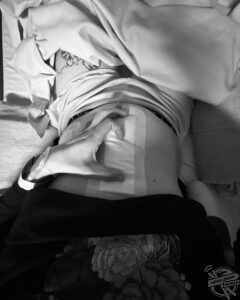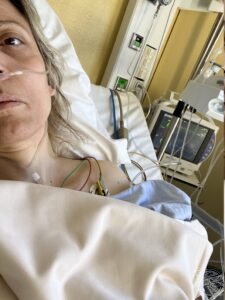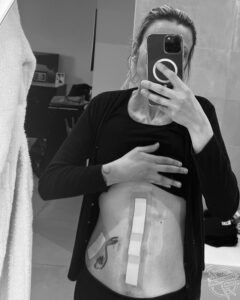By Aimee Braniff Cree
**EXCLUSIVE**
MEET THE WOMAN who has baffled doctors after being diagnosed with a total of five rare medical conditions, such a rare combination even medics do not know how many people suffer this.
Alexandra Bucille (43) from Versailles, France has had pain all her life, as a child she was hospitalised and in her teenage years the pain became unbearable.
Alexandra has had many investigative diagnostic procedures because most of her conditions are not visible.
Following years of testing Alexandra has been diagnosed with endometriosis, Thoracic Outlet syndrome, May-thurner syndrome,Nutcracker Syndrome and AVF.
Endometriosis is a disease in which tissue similar to the lining of the uterus grows outside the uterus. It can cause severe pain in the pelvis and make it harder to get pregnant.
Thoracic outlet syndrome (TOS) is a group of disorders that occur when blood vessels or nerves in the space between your collarbone and your first rib (thoracic outlet) are compressed. This can cause shoulder and neck pain and numbness in your fingers.
May-Thurner syndrome is a rare vascular condition that affects a vein in your pelvis. It occurs when a nearby artery compresses the left iliac vein. This vein brings blood from your pelvis and legs back up to your heart. The compression prevents blood from flowing properly, leading to narrowing and scarring.
Nutcracker syndrome is a rare vein compression disorder. It occurs when arteries, most often the abdomen’s aorta and superior mesenteric artery, squeeze the left renal (kidney) vein. It can cause many symptoms in both children and adults, such as flank pain and blood in the urine.
An arteriovenous fistula (AVF) is an abnormal connection between an artery and a vein. When there is a fistula in the brain, we call it an arteriovenous malformation (AVM). When a fistula occurs near the dura (the covering material of the brain), it is a dural arteriovenous fistula.

Living with a multitude of rare conditions has made life difficult for Alexandra, most recently she had to have an autotransplantation of her left kidney as her renal vein was compressed as a result of her Nutcracker Syndrome.
“I have several rare and genetic syndromes. I have always had pain since my teenage years,” said Alexandra.
“I was also hospitalised when I was little and then my general condition deteriorated.
“I have undergone diagnostic wanderings due to the fact that my pathologies are not visible, for example my migraines and endometriosis were difficult to get diagnosed and at the time we didn’t talk about it as much in the media.
“Following my umpteenth more intense crisis, my oldest daughter had to call the firefighters who came and transported me to the emergency room. I was having a thrombosis.”
Alexandra wants to shine a light on what many consider invisible disability as it affects her life in so many ways .
“The invisible disability and chronic pain is very important to me in rare diseases as are all my pathologies because I suffer the gaze of people who do not understand this permanent daily struggle,” she said.
“The strength it requires to fight against the disease and to do it with the smile because I often say we do not choose but it is up to us to face it by choosing to make it a strength.

“I think that it is necessary as much as possible to be aware of rare diseases because they are not sometimes seen or that there are not many of us that we are not really there to fight.”
Alexandra‘s health has seen her in hospital more times than she can remember and she insists she has had enough surgery for ten people.
“I’m waiting for the next autotransplantation of my left kidney on May 3rde 2023 at Annecy General Clinic (from left to right) because the renal vein is compressed, it’s the nutcracker syndrome,” she said.
“I was operated on for bilateral thoracic brachial defile syndrome, for pelvic and ovarian congestion caused by my endometriosis.
“I also have two stents in my iliac vein due to my May-Thurner Syndrome. These are vascular compressions.
“I am followed in a pain centre where I am equipped with a Tens Machine, I have to follow physiotherapy sessions.
“I spend a lot of time between laboratories and hospitals for appointments.

“I also have raynaud’s syndrome and chronic fatigue. In reality I suffered in silence because I suffer so much pain in several parts of my body where surgeons or doctors sometimes don’t know what to do.
“They ended up diagnosing me with a new syndrome, thoracic outlet syndrome.
“For the May-thurner syndrome I had to undergo the placement of two stents in the iliac vein after having already undergone two operations for my ablations caused by my thoracic outlet.
“Then as it continued to get worse I had operations for the congestion of the pelvic varicose veins, but there they found during the phlebographie a new syndrome the Nutcracker which is the compression of the renal vein and in my case my kidney is in hypertension.
“I have terrible pain in my left flank, it’s very difficult for me to stand or even sit for a long time, at the moment I even limp due to my stents.
“I am on antiepileptics to treat migraines, I also have triptan syringes, I have blood thinners for my stents and a bunch of other things to take.
“I just had blood tests for autoimmune diseases because I already have raynauds.
“I can no longer exercise due to chronic fatigue and pain and the time I spend taking care of myself.
“However, the more we talk about it, the more we inform, the further the research progresses, the less alone we are.”
ENDS










